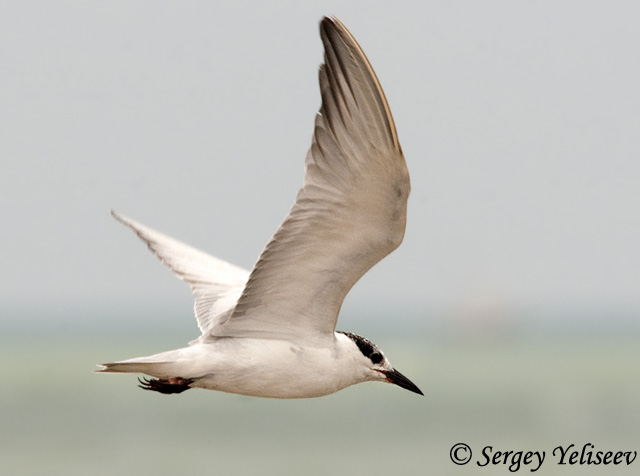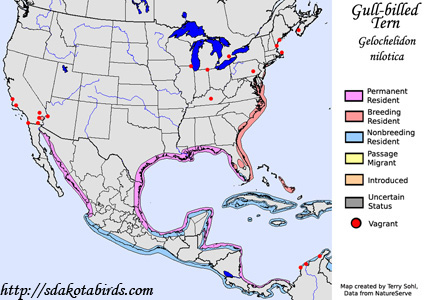| Length: 14 inches | Wingspan: 34 inches | Seasonality: Non-resident in South Dakota |
| ID Keys: Thick black bill, light body plumage, dark cap in breeding plumage, cap reduced to small gray patch behind eye in non-breeding plumage | ||
 The
Gull-billed Tern is named for the unusually thick bill for a tern.
While other tern species are often seen flying over water and diving for
fish, the Gull-billed Tern prefers to feed on insects, and is often found
foraging over terrestrial habitats. They are a very widespread
species, with populations found in the warmer parts of Europe, Asia,
Australia, Africa, and South America, as well as the warmer areas of North
America.
The
Gull-billed Tern is named for the unusually thick bill for a tern.
While other tern species are often seen flying over water and diving for
fish, the Gull-billed Tern prefers to feed on insects, and is often found
foraging over terrestrial habitats. They are a very widespread
species, with populations found in the warmer parts of Europe, Asia,
Australia, Africa, and South America, as well as the warmer areas of North
America.
Habitat: Found near coastal areas in North America, with notable exceptions of the Salton Sea in California, and some inland areas in southern Florida. Much of their foraging is done on inland habitats adjacent to the coast, particularly open areas such as marshes, wet meadows, or agricultural land.
Diet: Feeds heavily on insects, but will also feed on small crustaceans, mollusks, marine worms, amphibians, small rodents, and small birds and bird eggs.
Behavior: Most foraging is done from flight, with slow observation flights interrupted by dives to the ground or water when food is spotted. They may also catch insects in mid-air. They will also sometimes forage by walking along the shoreline.
Nesting: The nest of Gull-billed Tern is a depression on the ground, lined with plant material and debris. The female lays between 1 and 4 eggs, and both parents help to incubate them. When the eggs hatch, both parent help to feed them. The young fledge at about 5 weeks.
Song: The most common call of a Gull-billed tern is a nasal kai-WEK.
Migration: Some are evidently permanent residents along the Gulf Coast. Those on the Atlantic Coast are only present during the summer months, with birds likely wintering along the Gulf Coast, in the Caribbean, or coastal Mexico.
Interactive eBird Map: Click here to access an interactive eBird map of Gull-billed Tern sightings
Similar Species: Sandwich Tern
Conservation Status: There are signs that populations may be decreasing, but they are still found over a very wide geographic area, and are commons in some regions. The IUCN lists the Gull-billed Tern as a species of "Least Concern".
Further Information: 1) Audubon Guide - Gull-billed Tern
2) BirdLife International - Gull-billed Tern
3) Cornell's All About Birds - Gull-billed Tern
Photo Information: Photo taken by Sergey Yeliseev - March 5th, 2011 - Sri Lanka - Photo licensed under Creative Commons Attribution NonCommercial NoDerivs 2.0 Generic License.
| Click below for a higher-resolution map |
 |
| South Dakota Status: Non-resident in South Dakota |
Additional Gull-billed Tern Photos (coming soon!!)
